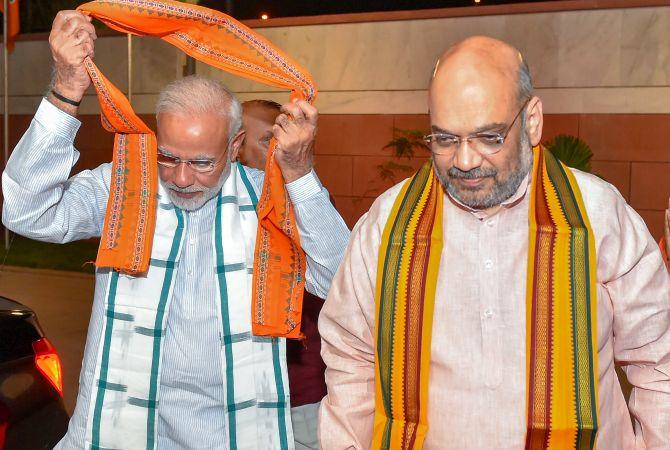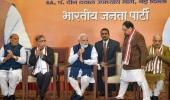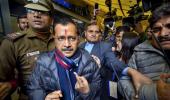Prime Minister Narendra Modi and Home Minister Amit Shah will soon get around to reworking their organisational set-up and administrative priorities to regain lost ground in the wake of the Delhi electoral debacle, but there’s third course available to them as well.
That is to introduce the presidential form of government, which prime ministers Indira Gandhi and A B Vajpayee flirted with before abandoning it. Will Modi go further than them?
N Sathiya Moorthy analyses the scenario.

All things told, the Delhi poll victory is a positive vote for Chief Minister Arvind Kejriwal and his AAP government, even though the share of anti-CAA votes may have consolidated more than ever.
In both, there is a stronger message for the ruling BJP at the Centre, which is holding whatever states it now rules -- barring the singular exception of Uttar Pradesh among the biggies -- mostly to post-poll manipulation than a positive vote for Prime Minister Narendra Modi and his own kind of aggressive and at times offensive politics.
Delhi is India’s capital. It is also a li’l India, though in terms of castes and religions, regions and language, the proportion of the local population may not exactly reflect the ground situation. The people there needed good governance, which translated as clean drinking water, functional hospitals and performing schools, all in the government sector.
After fighting a constitutionally losing battle on police powers and the governor of the day, Kejriwal understood the limitations on being chief minister of a state where the Centre’s writ ran wider and deeper -- and also longer. He may or may not have acknowledged the realities and compulsions on this score, but that is irrelevant. Once he had understood his own limitations, it seemed to have been easy for him to work with whatever powers the Delhi state government had, and work on those weaknesses as his ultimate strength.
Today after all this, if Kerjiwal and AAP were to demand more of the policing powers for the nation’s capital, then who knows, more voters in the state may back him. That owes to his proven track record and that of his government, if not all the ministers -- but then who in political Delhi can claim that the Union council of ministers is full of gems, and none else.
But then, after his experience and exposure to political administration, Kejriwal may be the last man to demand police powers, not that BJP’s Amit Shah as Union home minister, will be ready to pass it on…
All this does not mean that the BJP has lost the electoral race and for good, or that its ‘Hindutva/intolerance’ card has not paid off in Delhi as it had hoped for.
If anything, the higher poll percentage for the party this time compared to the previous one, and the AAP winner, too, losing vote share as seat share, is indicative of what really happened at the grass-roots.
Yet, the fact that some of the outrageous campaign-themes of the Modi-Shah combine, and most of their MPs, including 70 ministers, each one of them addressing their ‘back-home’ constituency in the capital, could not help them win the elections, has sent out a message that is still hard for the party leadership to digest first, and introspect, afterwards.
The fact that Delhi BJP chief Manoj Tiwari has been made to own up the party’s defeat even when the whole world knew that he was the last one at whose door the buck stops is indicative of a Congress-like mindset, which the ruling party at the Centre clearly finds difficult, to distance from even full six years after emerging as the single largest party across the country (barring those island-like Tamil Nadu, Kerala and possibly west Bengal, too). Assembly elections are due in all three states, beginning with those for the eastern state this very year.
Independent of the results in these and other assembly polls, it is now a settled issue that the BJP is the single largest party in national terms and for parliamentary polls, and PM Modi is the single most popular leader. It was the case with Indira Gandhi in her time as PM (until after emergency) and of Atal Bihari Vajpayee in the same chair. The post-emergency parliamentary polls of 1977 and that in 2004 proved that the popularity of the leader and his/her greater acceptance at the voter-level would not necessarily always mean that the party they head would sweep the elections again.
This is because at the end of it all, parties need a local face, even for LS polls after a point as voters get tired of the prime faces and their unfulfilled aspirations and the unkept promises. Parties thus need a strong second line to win elections on a rainy day, when the face that launched the votes earlier alone would not suffice.
The Modi-Shah duo not only encourage a second-line from the states, they also climbed over the ashes of a strong second-line that the BJP could boast of at the national level too. Indira Gandhi deliberately destroyed the established and well-entrenched second-line in the Congress, only because they were well-entrenched, as the vertical split in the party showed her in 1969.
In organisational terms, there are two ways for the BJP to face future elections, especially to the Lok Sabha that is not due before 2024. Of course, they may have to revisit their policy priorities in between, moving away from politics (where alone they continue to be strong) and focussing on the economy (where they continue to expose their ignorance and inadequacies).
The leadership needs to prepare itself to acknowledge economic realities that are at the root of a ‘welfare State’, which India still is, but fed from a different source and through a different modus than the failed ‘socialist’ experience of the by-now-forgettable Congress predecessors of the Nerhuvian era. The BJP faced a similar ‘crisis of conscience’ when PM P V Narasimha Rao pulled ‘Manmohanomics’ out of the proverbial hat. The Vajpayee-Advani leadership was left fumbling, if not fuming, at their inherent inadequacies.
Their defeatism was even more when they had thought the ‘Ayodhya rath yatra’ had worked wonders for the party’s poll prospects, despite the dampening ‘Mandal issue’ introduced by V P Singh at too late an hour for any electoral comfort for the latter. The resultant ‘Ayodhya demolition’ meant that PVN had also demolished the BJP’s only vote-getter of the time.
Last year’s Supreme Court verdict in the ‘Ayodhya case’ may have done likewise for the Modi-Shah leadership,
The alternative to harping on such ‘Hindutva’ political themes, apart from addressing the economics, starting with learning the basics of contemporary international scenario, and adapting to the same, is to consciously develop a strong and charismatic second-line at every level from the districts upwards.
Whether the leadership’s sense of over-confidence and security/insecurity would permit that, is another question they may have to ask themselves and find answers for. The issue is, if they do want a Modi government or a BJP government in 2024, of course, with Modi still at the helm.
In which case, there is a third alternative. Both Indira Gandhi and Vajpayee tested the waters in their time, but obviously decided not to proceed with the same. Bringing in a presidential form of government, where the independent popularity of the individual matters more than that of the party.
The leadership when Vajpayee was PM did try out the trick. Including the number two man in the government, L K Advani, hinted at the possibility of considering the presidential alternative, and second-line leaders freely spoke of the same up to a point.
Arguments citing the ‘successful’ (?) American experience and the advocacy of the late Nani Palkhivala apart, there was an obvious attempt at upping the stakes for the weak political Opposition of the time with no popular leader in the range of Vajpayee, who would have won direct elections hands down -- or, so seemed the BJP’s calculations of the time.
Though at commencement of the one-sided public discourse on the need for ‘reviewing of the working of the Constitution’ in the late ’90s included the need for referring the matter to a commission of inquiry, the terms of reference for the Justice M N Venkatachalaiah Commission did not contain the same. Indications were that the ruling BJP leadership was no more confident of a winning a direct presidential poll with the near-exclusive support only of the ‘Hindi belt’, as happened for the post-emergency ‘Janata Party experiment’.
As was reckoned at the time, even the divided Opposition that had lost both parliamentary seats and assembly control in those states, did have more than a fair vote-share. The Opposition also controlled more vote-shares in the south and the east, where the BJP was a non-starter.
Today, when the BJP has only Modi to project and Shah to strategise, the temptation of some back-bencher MPs to promote the presidential form, if only to ensure their own electoral victory in 2024, is something few of them can eschew. Of course, any constitutional amendment in this regard requires not only a two-thirds majority, which the BJP-NDA may not be able to manage at present, but may still require a majority of state legislatures too approving of the same.
The latter looks like a far cry just now, and the temptation thus could be for the party strategists to manipulate the same beforehand, which they are past masters at.
But before that the top two will have to decide on the future course, a combination of reworking the organisational set-up and administrative priorities, alongside a change to the presidential form -- or, the latter independent of the other two.
The only caveat just then would be if the Indian voter would be buy it, or if he would vote the 1996 way, when the ruling Congress was known to be losing already and the BJP had hoped to win -- but ended up losing to a post-poll combination of victorious regional parties. But that is a tall order, on which the BJP just now can rely on, even more.
Of course, the ‘presidential form, if taken up and clears the legislative process, may still have to face judicial review. The question then would be if the change-over from the current parliamentary form of government would be violative of the ‘basic structure’ theory propounded by the Supreme Court in the ‘Kesavananda Bhaati case’ (1973), or the latter would require a review -- as may have become fashionable since.
N Sathiya Moorthy, veteran journalist and political analyst, is Distinguished Fellow and Head-Chennai Initiative, Observer Research Foundation.










